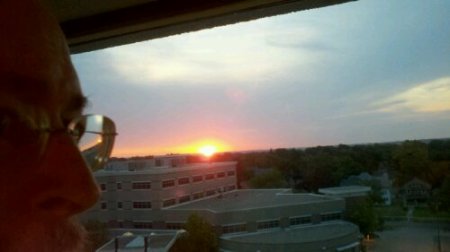If it helps to make a decision
We like a CAT scan’s precision
It sure made my day
When in truth I could say
It looks like you’ve dodged an incision.
Synopsis: I’m a Family Practitioner from Sioux City, Iowa. In 2010 I danced back from the brink of burnout, and honoring a 1 year non-compete clause, traveled and worked in out-of-the-way places in Alaska, Nebraska, Iowa, and New Zealand. I followed 3 years Community Health Center work with a return to traveling and adventures in temporary positions in Alaska, rural Iowa, suburban Pennsylvania and western Nebraska. 2017 brought me adventures in Iowa, Alaska, and northern British Columbia. After a month of part-time in northern Iowa, a new granddaughter, a friend’s funeral, and a British Columbia reprise, and my 50th High School reunion, I’m back in Northwest Iowa. Any identifiable patient information has been included with permission.
I arrived 15 minutes early for a brand-new gig. I started the usual orientation: meeting a lot of people whose names I forget and shuffling around a confusing geographic set-up.
No one expects me to remember everything the first day, but much like any other human learning endeavor, one has to find a starting point,
The facility has three EMRs, one each for the hospital, the clinic and the ER. The ER and hospital systems communicate with and resemble each other, but do not qualify as twins. And I’ve used the hospital system before, in Nome and in western Nebraska.
The outpatient system, however, looks like nothing I’ve ever seen.
For reasons I don’t completely understand, my schedule keeps changing, and I covered an outlying clinic in the afternoon.
I cared for 5 patients, including 2 children, both of whom I mesmerized with my yoyo. I managed to not increase anybody’s prescription burden, recommending only agents available over-the-counter.
Not a single patient came to the ER that night, yet the vigilance of call kept me up.
I only attended 8 outpatients and an inpatient the next day, yet high-stakes clinical material dominated the landscape. I sent two patients to the CT scanner down the hall. Surprisingly, the results swayed the decision-making process in both cases. Neither went to surgery nor to inpatient.
A different patient became my first admission to the hospital. The wonderful nurses gave me the choice of writing my orders or entering them into the computer system. Grinning, I took the hand-written option, and later watched a new-hire nurse struggling through an unintuitive system.
The glitch that prevents me from using the outpatient system for entering lab and x-ray orders or for electronic prescribing continues to defy resolution. The management here lets me write my orders on plain paper and have the nurse enter them into the computer. I dictate my notes.
And I finished on time. For whatever reasons, for the time being I can enjoy slow patient flows.
The patients have already started asking if I’ll move here. Forever. I thank them, but I decline; Bethany and I still have more adventures to look forward to.
